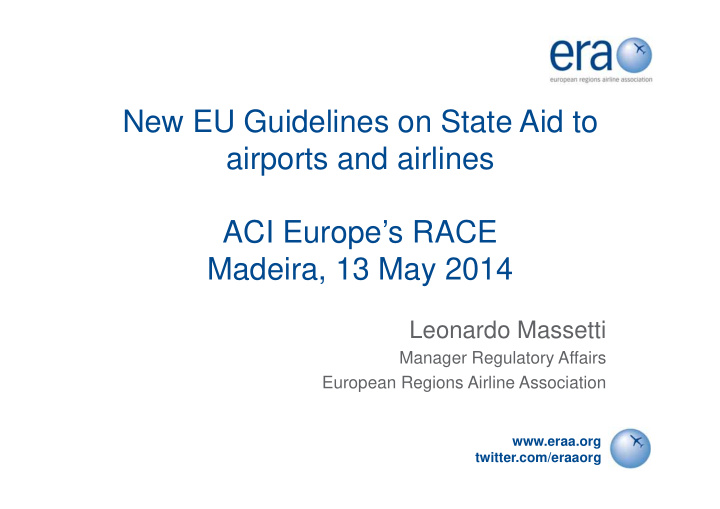



New EU Guidelines on State Aid to airports and airlines ACI Europe’s RACE Madeira, 13 May 2014 Leonardo Massetti Manager Regulatory Affairs European Regions Airline Association www.eraa.org twitter.com/eraaorg
About ERA • 50 airline members • 20 Airports • 93 Suppliers • 10 Manufacturers • 960k flights per year • 45 million passengers per year • 71 minute average sector time • 67 seats average seating capacity • 800 aircraft • 1,200 routes • 32 countries across Europe www.eraa.org twitter.com/eraaorg
��������������������� www.eraa.org twitter.com/eraaorg Source: Jean-Yves Grosse, Chairman, Regional presentation at ERA RAC2013
������������������������ www.eraa.org twitter.com/eraaorg Source: Jean-Yves Grosse, Chairman, Regional presentation at ERA RAC2013
European Air Transport Market • The air transport market has evolved dramatically in recent years. � Low-Cost Carriers (LCCs) have developed new business models linked to regional airports • Market share (over 40% in Europe). • Volatility in entering/quitting an airport � Europe’s regions are losing links with capitals via the hub airports � - an 11% decline in 10 years www.eraa.org twitter.com/eraaorg
Case Study � 2010: ERA member airline (“Air ERA”) complained about illegal State Aid to its main domestic competitor airline (“Competitor”) received from airport � 2011: European Commission opened investigation � 2013: Complaint lodged before National Competition Authority � 2013 : National Court of Appeal judgement www.eraa.org twitter.com/eraaorg
Case Study � Existence of State Aid and use of public resources � No ex-ante business plan � No pre-notification to EC � Market Economy Operator Principle dismissed � No tender procedure before granting Aid � marginal revenue for the public entity is a consequence of abuse of dominant position ( dominant company applying dissimilar conditions to equivalent transactions ) � Clearly selective and discriminatory advantage www.eraa.org twitter.com/eraaorg
Case Study � It’s all about money: • Air ERA had to stop its activities at the airport in question as direct consequence of arbitrary, selective and discriminatory aid to competitor and tax increase (+170%) on transfer passengers • Competitor became monopolistic operator in some routes: ticket fare increase up to +85% • 2011-2013: airport revenues fell by 45% • 2011-2013: airport passenger traffic fell by 35% www.eraa.org twitter.com/eraaorg
Case Study � It’s all about money: • 2011-2013: airport number of landings fell by 48% • Public airport shareholders exit • 2013: Air ERA had to phase out 80% of its fleet • 2011-2013: Air ERA lost € 25 m as a direct consequence of discriminatory treatment www.eraa.org twitter.com/eraaorg
Lessons learnt � TIME TO OBTAIN COMPENSATION TOO LONG TO SURVIVE COMMERCIALLY � OLD GUIDELINES ALREADY CLEAR � TRANSPARENCY NEEEDED BEFORE AID GRANTED � SIMPLE, EFFECTIVE AND EXPEDITIOUS COMPLAINTS PROCEDURE � OVERSIGHT OF IMPLEMENTATION AND FAIR ENFORCEMENT www.eraa.org twitter.com/eraaorg
• Positive elements of Commission’s new Guidelines : � More flexibility for aid to peripheral and remote regions � compliance with Regulation 1008/2008 on Public Service Obligations and Directive 12/2009 on airport charges are steps in the right direction � More flexibility for operating aid to smaller airports (< 700 000 pax), however 4-year review clause means business uncertainty www.eraa.org twitter.com/eraaorg
What about the new Guidelines? • Passenger traffic growth 2001-2010 (ACI-Europe): � +81% (EU airports < 1 mil./year) • Cost-Benefit analysis for EU airports <1 mil./year): � € 445 million (potential public funding to cover annual losses) � € 16.15 billion + 265,000 job (annual contribution by airports < 1 mil./year) www.eraa.org twitter.com/eraaorg
What about the new Guidelines? Preferential treatment to rail transport? No start-up aid to airlines allowed on routes already covered by HSR, however heavy subsidies to rail transport allowed although commercially profitable air link already operating www.eraa.org twitter.com/eraaorg
� They acknowledge that airports < 1 mil. pax/year need State Aid to financially survive • Why do they require airports above 700.000 pax/ year to survive without public support? � They acknowledge capacity crunch and congestion at European main airports. EUROCONTROL: “ by 2030 19 out 20 majors airports to be heavily congested ”: • What happens if we reduce the number of airports? www.eraa.org twitter.com/eraaorg
What about the new Guidelines? " good aid " : sustainable aid addressing market failures; equity objectives in the interest of growth and jobs, such as regional investment aid Proposed “solutions” to regional airports: • increase charges to airlines (highly competitive market, tiny margins = very unlikely to happen) • Rationalisation measures (= cutting jobs?) www.eraa.org twitter.com/eraaorg
• Transparency not particularly improved: � costs and charges at EU Airports (irrespective of size/volume of passengers) to assess any differentiation and rebates � disclosure of information regarding State Aid after it’s been granted � start-up aid schemes are not duly advertised before they are granted www.eraa.org twitter.com/eraaorg
Conclusion • Regional Airports and Airlines are vital contributors to keeping Europe connected • They play a great social and economic role to regional Communities’ development • BUT simple, transparent, effective rules are needed to ensure competition is not distorted Closing regional airports is not a good option www.eraa.org twitter.com/eraaorg
Thank you for your attention Leonardo.Massetti@eraa.org www.eraa.org twitter.com/eraaorg
Recommend
More recommend